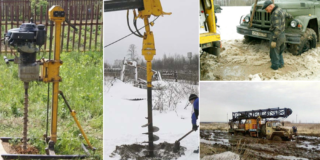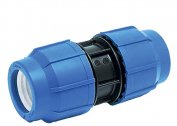Water is the most significant source not only in the house, but also in the summer cottage. Without it, life for the sake of a metropolis becomes uncomfortable. You will need to bring bottles of store water with you. For this reason, many people, having acquired an open area, initially think about water supply. The first idea that appears is the installation of a water supply system.
Types of wells
 Before you start drilling wells, you should carefully examine the area of your own site and find out at what depth groundwater lies. This parameter is very significant, as it has a strong effect on the volume of work performed.
Before you start drilling wells, you should carefully examine the area of your own site and find out at what depth groundwater lies. This parameter is very significant, as it has a strong effect on the volume of work performed.
Selection of the type of well is based on the depth of the water-containing layer:
- If on-site water is available at a depth of 3-12 meters, then in this case the Abyssinian well is preferred.
- If the aquifer is at a depth of 50 m, then a sand well is set up.
- The installation of an artesian well is resorted to if the layer having water is located at a depth below 200 m.
Wells of the 1st and 2nd types can be created by any owner of a summer cottage. But to drill a third is not so easy. To do this, it is necessary to involve high-class drillers in the work, which use special special equipment to ensure the formation of a water supply source.
Do-it-yourself well drilling methods
 Do-it-yourself drilling, as a rule, is arranged by the owners in order to reduce cash costs, save on calling experts and attracting high-class equipment. However, don’t worry, this is a rather complicated workflow, which can be carried out by appropriate methods:
Do-it-yourself drilling, as a rule, is arranged by the owners in order to reduce cash costs, save on calling experts and attracting high-class equipment. However, don’t worry, this is a rather complicated workflow, which can be carried out by appropriate methods:
- auger;
- shock-rope;
- hydrodrilling using a needlework design.
The first method is the most common. It consists in drilling a well with a drill and using a tripod with a screw, which will require constant extraction, to clean the blades of sticky soil. In addition, you need a lifting device, it can be manual or mechanized. This type of drilling is suitable for soft soil.
On clay soil they work on the principle of shock-rope drilling. This is the most time-consuming method, but quite acceptable for a personal embodiment. In this case, a difficult hydraulic cylinder with trimmed blades acts as a boring device; it rises above the ground and, when struck, is boiled deep, and when it is lifted, the soil turns out.
The third method is to create a drilling machine with your own hands in accordance with the instructions. This, of course, will take a lot of time, but it will be possible to reduce the cash costs of attracting special equipment. Hydro-drilling makes it possible to produce wells up to 50 meters deep, which call for casing.
What time of year to drill a well
 For some reason, many people think that all construction and drilling work is more correct to carry out in the warm season, which is partly correct in principle, since in winter the soil freezes and complicates the work. But for many years in a row, in almost all areas affecting the work with soil, equipment has been used that simply passes through frozen soil. Drilling wells is not considered an exception to this list. Therefore, it is possible to simply note that drilling is allowed to be carried out both in winter and in summer.
For some reason, many people think that all construction and drilling work is more correct to carry out in the warm season, which is partly correct in principle, since in winter the soil freezes and complicates the work. But for many years in a row, in almost all areas affecting the work with soil, equipment has been used that simply passes through frozen soil. Drilling wells is not considered an exception to this list. Therefore, it is possible to simply note that drilling is allowed to be carried out both in winter and in summer.
Any season has its own pros and cons, but directly:
- Spring is a traditional period for construction, but spring floods increase the degree of groundwater and complicate the search for an aquifer;
- Summer is the period when the land is drained, and it is not difficult to find the aquifer, which is why those who are ready to wait for the suitable period usually expect summer and, accordingly, considerable bursts of drilling appear that negatively affect the quality of work of experts.
- Autumn - especially in the first months, is favorable for drilling: summer heat dried out the soil, and it is not difficult to establish an aquifer. This time of year is the best for drilling wells up to 25 meters deep. In the coldest weather, as a rule, “harvesting” of the zone for winter work is carried out - drilling the soil to the freezing depth.
- Winter is a period when, in spite of the generally accepted judgment, quite a few wells are being developed. In winter, precipitation has little effect on the degree of groundwater, and frozen soil in the area does not suffer from wheels of difficult machinery. Numerous landowners endure drilling for the winter, because during this period it is possible to obtain high-quality results for the lowest payment than in the summer.
How to choose a place
 Many owners of the sites believe that the location of the upcoming well depends only on their wishes, but this is not entirely true. Water in the ground, of course, is available in each area, but far from everywhere it will be able to provide the desired volume and quality. Aquifers in different areas are located at different depths, and the depth of drilling affects the price of the entire company. In accordance with this, it is in the interests of the owners to still select a zone for the well, starting more from the comfort of drilling, and not from personal tastes.
Many owners of the sites believe that the location of the upcoming well depends only on their wishes, but this is not entirely true. Water in the ground, of course, is available in each area, but far from everywhere it will be able to provide the desired volume and quality. Aquifers in different areas are located at different depths, and the depth of drilling affects the price of the entire company. In accordance with this, it is in the interests of the owners to still select a zone for the well, starting more from the comfort of drilling, and not from personal tastes.
In order to make water supply more comfortable and cheaper, it is necessary to place the well as close as possible to the house. At a minimum, the distance at which a water well can be located close to the base of the house is 3 meters. In addition, there should not be sources of clogging nearby - garbage pits, trash, landfills, dung heaps and the rest. The distance from them to the well must be at least 50-100 meters.
It is also not necessary to equip the well at the lowest point of the site - all flood waters will begin to approach it, and although they will not affect the quality of the water, the caisson may suffer from them.
To the area where it is planned to carry out drilling, a free access of special equipment should be provided. Directly for this reason, it is often difficult to drill a well in the summer season - special equipment violates the soil with wheels and fails to maneuver between flowerbeds and lawns.


